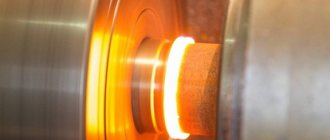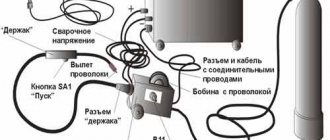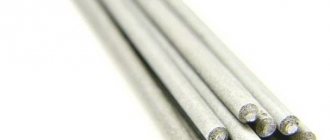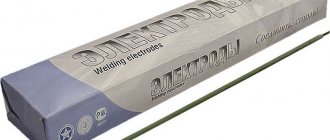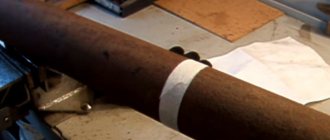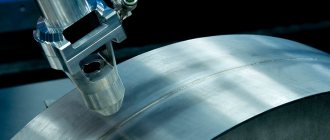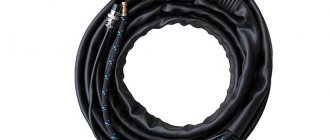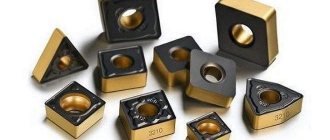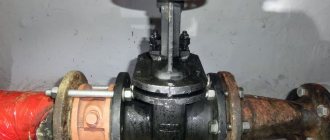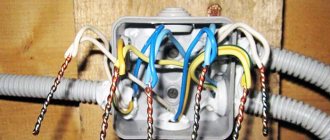Home / Electrodes
Back
Reading time: 4 min
0
2050
Copper and copper alloys are quite a difficult material for even an experienced welder to work with, but for a beginner it is absolutely a dark forest.
For successful work, only professional hands will not be enough; you will also need high-quality materials, because often they are the ones who decide the outcome of the work. Poor quality equipment can play a fatal trick even with a real specialist.
When you start welding with such a complex metal, you will be prepared for a number of difficulties. There can be a lot of problems, starting with the fact that the metal can become porous, that is, not solid, ending with oxidation, which will significantly reduce the quality of this work.
- Electrodes for copper
- Electrode names
- Selected models
- Nuances of operation
- Bottom line
What brands of electrodes are used for copper welding
For welding, surfacing of copper and non-ferrous metals, welding of copper pipes, etc. Special copper electrodes are used for welding. Electrodes of this type include
- Komsomolets-100,
- OZB-2M,
- OZB-3,
- ANTs/OZM-2,
- ANTs/OZM-3,
- ESAB OK 94.25,
- ESAB OK 94.35,
- ESAB OK 94.55,
- ESAB OK NiCu-7 (OK 92.86),
- ESAB OK Ni-1 (OK 92.05),
- ZELLER 390.
You need to start working with them knowing some of their features and characteristics.
Komsomolets-100 is intended for surfacing and welding of copper grades M1-M3. Work should be carried out on direct current (about welding currents here), in the lower or inclined positions. Komsomolets-100 electrodes with a thickness of 3-5 millimeters are produced. Recommended current for a diameter of 3 mm is 90-180 amperes, 4 mm 120-140, 5 mm 150-190. These indicators depend on the position of the seam. Before starting work, it is recommended to heat the product to be welded to 300-700 degrees, depending on its thickness.
OZB-2M is also designed for working with bronze used in artistic casting. They can be used to fuse it onto steel and correct defects in cast iron. In this case, it is necessary to turn on the current of reverse polarity, and work in a vertical or horizontal position. OZB-2M consist of copper, iron, phosphorus, manganese, nickel and tin. Their length is 350 mm. For successful operation, it is necessary to set the welding current to the following values: for a diameter of 3 mm / 90 - 120 amperes, 4 mm / 120 - 160.
OZB-3 are used when working with non-ferrous metals, copper and bronze. They are made with a special coating (find out more about electrode coatings here). Welding should only be done in the down position. Direct current is used. The coefficient and productivity of surfacing OZB-3 is 12.5 g/Ah – 3.5 kg.h with a product diameter of 4 mm.
ANTs/OZM-2 is used to work with pure copper, and there is no need to heat it if it is not very thick. Welding should be done in an inclined or downward position. Direct current of reverse polarity is used. ANTs/OZM-2 consumes 1.6 kg to melt a kilogram of metal.
ANTs/OZM-3 are needed for working with copper products of technical grades in accordance with GOST 859-78. They are produced in thicknesses of 4-6 mm. To successfully perform welding, you need to set the current to 220-300 amperes for a diameter of 4 mm, 350-400 for 5 mm, 420-600 for 6 mm. The seam position should be down. You need to work with a short arc, with copper up to 10 mm thick, without heating, without cutting edges, using a single or double-sided seam with slight transverse vibrations of the electrode.
ESAB OK 94.25 is well suited for working with many non-ferrous metals and alloys. Especially with copper, tin bronze, burnt cast iron, brass. They can be used for surfacing steel to protect it from corrosion. It is recommended to heat thick copper products to 300 degrees. It is best to work with ESAB OK 94.25 in spatial positions 1-4.
ESAB OK 94.35 has a thick rutile coating. Used when working with products made of copper and nickel, with the latter content up to 30%. ESAB OK 94.35 electrode is used to fuse the edges. They can be used in 1-5 positions. The metal deposited with their help is endowed with excellent corrosion resistance, it is not afraid of prolonged exposure to sea salt water, and is endowed with good strength characteristics.
ESAB OK 94.55 have a basic coating type.
The electrode is good at working with bronze, red brass, and copper. Welding is usually performed with a short arc. The location of the electrode should be perpendicular to the edges. It is necessary that the weld beads are located one on top of the other. Important! The surface of each passage must not be forgotten to be cleaned of slag.
Suitable positions for work are 1-4 and 6. Tensile strength 400 MPa, hardness 120 HB. The brand ESAB OK 94.55 with a diameter of 2-4 mm is produced.
ESAB OK NiCu-7, or OK 92.86 , is used for welding copper and nickel. The metal deposited with their help is characterized as resistant to cracking, malleable, resistant to sea water, acid and alkali. Cook with this electrode in 1-4, 6 positions. This brand is produced with a thickness of 2-4 mm. The operation uses direct current of reverse polarity.
ESAB OK Ni-1 , formerly OK 92.05, has a basic coating type. To prevent the formation of cracks and pores, it is recommended to work only at currents permissible for a particular electrode diameter. Suitable for 1-4, 6 positions. The electrode is calcined for two hours at a temperature of +250 degrees. Requires direct current to operate.
ZELLER 390 has a base coating. Tensile strength 200 MPa, fluidity 185, hardness 40 HB. ZELLER 390 is available in different lengths, from 300 to 450 mm, with a diameter of 2.5-5 mm. The current strength must be set for an electrode with a thickness of 2.5 mm/80-110 amperes, 3 mm/100-130, 4 mm/130, 170 mm, 5 mm/170-200. It is used when working with products that must meet high levels of resistance to corrosion, thermal conductivity, and electrical conductivity.
[ads-pc-2] [ads-mob-2]
Soldering copper pipes as a connection method
When using soldering, a special pipe connection is most often used: one of the ends of the pipes has a larger diameter than the main pipe, with this end it is put on the pipe being connected.
After cleaning and degreasing the pipes, soldering acid is applied to the surfaces to be joined, after which the pipes are connected to each other. Heating is carried out with gas-flame burners. When the required temperature is reached, solder is supplied, and it melts due to the flame of a gas burner and the heated surface. Under the action of capillary forces, liquid solder is evenly distributed over the surfaces to be joined. Most often, tin-based solders are used for soldering copper pipes.
When using any of the listed welding and soldering methods, high quality seams will be ensured through strict compliance with all welding requirements.
Popular manufacturers of electrodes for working with copper and other metals
Esab electrodes have proven well. Its grades ESAB OK 94.25, OK 94.35, OK 94.55, OK NiCu-7 (OK 92.86), OK Ni-1 (OK 92.05) are used all over the world. This Swedish company was founded in 1904. The corporation is engaged in the production of welding machines for various purposes, modifications, and fluxes. ESAB has developed many modern welding methods to meet the demands of progress .
NPO Spetselektrod LLC is engaged in the manufacture of brands of electrodes used for all purposes. The following brands have proven themselves well for working with non-ferrous metals: ANTs-3, ANTs/OZM-2, ANTs/OZM-3, ANTs/OZM-4, OZA 1 and 2 and many others. This is a Russian company, its products are inexpensive and reliable.
Zeller electrodes have been produced by a German company since 1963. The catalog contains more than 500 product names. Its electrodes meet the highest requirements, are endowed with excellent corrosion resistance, and form a strong, reliable seam.
Often welders and suppliers of materials for them recommend the following manufacturers:
- – PlasmaTek;
- – Kobe Steel, Japan;
- – Lincoln Electric;
- – Sudislavsky Welding Materials Plant, Kostroma Region;
- – plant E.O. Paton and some others.
How to solder copper pipes with your own hands
In private households and in production, only two methods are used for soldering products made of copper and alloys:
- Soldering at high temperatures, the so-called “hard soldering”, when the solder melts in the range of 600C-900C. To solder a copper part, use refractory solder, and you will get a strong, reliable seam that can withstand heavy mechanical loads;
- Low-temperature “soft” soldering (≤ 450C) is used in everyday life. Low-melting solder is used to connect tubes or seal cracks.
To get a reliable result, use the following tool for soldering copper pipes:
- Pipe cutter, grinder, jigsaw, hacksaw;
- A chamfer, which is used to clean the cut ends of copper pipes;
- Soldering iron - electric of varying power, gas, or an old design, heated over an open fire. Also, sometimes soldering is carried out with a gasoline blowtorch or a gas welding torch. Electric soldering irons are suitable for soldering with hard and soft solder; gas soldering irons are better suited for working with hard solders and corresponding additives such as borax;
- Expander - a device that expands the end of one product so that it can be inserted into the edge of the second;
- Solder is selected for each mode. For hard soldering of the heating line, copper wire with phosphorus admixtures is suitable, for low-temperature connections - tin solder with lead additives;
- Additives (flux) can be liquid or solid, acidic or alkaline, and are designed to clean solder surfaces from oxides. The most common flux in everyday life for soldering copper products is rosin and borax.
If a large area is being repaired, then to regulate the melting temperature of the solder, use a construction industrial hair dryer with nozzles of different designs that allow you to regulate the flow and direction of hot air. Tools and accessories also include sandpaper, a wire brush, rags, and brushes.
Rod material
Electrode rods for welding copper and its alloys are made from wire and rods, the composition of which meets the requirements set out in GOST 16130-90. Mostly it is copper or bronze. Metal alloys are often used in production.
- Copper rods are made with a diameter of 2-6 mm, they can be wrapped in tin 0.3-.05 mm thick. They are coated with various types of coating, for example, basic or rutile. For the Komsomolets-100 electrode, the rod is made of M1 copper.
- Bronze rods are made mainly from metal grade BrKMts-3-1. They are coated with a mixture of different substances. They can also be made from tin-phosphor bronze Br.FO 4-03.
- Bronze rods ensure the creation of excellent quality seams. They deoxidize metal worse than those made of copper. Bronze rods may reduce the mechanical strength of the joint under certain conditions.
Preparatory stage
Like other metals, the surface of a copper workpiece requires thorough cleaning. The sequence is:
- apply acetone or a similar solvent to the rags;
- use it to remove dirt, dust, visible impurities of lead or sulfur;
- remove the oxide film with a stainless mesh, metal brush or similar abrasive until it becomes shiny;
- when the workpiece size is up to 0.5 cm, it is heated at a temperature of 200-300 degrees, more than 0.5 cm - no more than 700 degrees; Large and thick workpieces take longer to warm up.
Now - about well-known working methods.
General principles of electrode welding of copper and its alloys
When welding copper and its alloys, the welder faces some difficulties. A crack may form at the seam. During operation, low-melting eutectics accumulate at the crystal boundaries. Pores often form. All this is important to take into account and prevent. Copper up to 4 mm thick is welded without cutting edges, up to 10 mm thick with one-sided cutting. In this case, the bevel angle of the edges should be 70 degrees, the bluntness should be 1.5-3 mm.
The fluidity of copper makes working in vertical, horizontal and ceiling positions difficult. Arc welding must be carried out at increased welding current due to the high thermal conductivity of the metal. The edges of the parts are connected with a minimum gap due to the high fluidity of copper. It is often recommended to use a steel backing.
It is better to preheat a product with a thickness of more than 6 mm to 250 degrees. In this case, it is necessary to take into account the melting characteristics of copper and its alloys. Thin metal is not heated. Welding is best done with an arc of 10-15 mm. This will make it much easier to manipulate the electrode. Copper is welded using a constant current of reverse polarity. This is important to consider. Arc welding of brass, bronze, M1-M3 must be performed with a powerful arc, increased current strength and at increased voltage . The work is done very quickly, at high speed .
If possible, welding is recommended to be done in the lower position or at an inclination angle of 20 degrees maximum relative to the vertical. The arc is directed directly to the weld pool. It is recommended to use special linings made of asbestos, flux, graphite, copper, steel. It is important to take into account all the main features and characteristics of the metal.
Reference. Copper melts at +1080 degrees, it has a specific gravity of 8.9 g/cm3, its strength is 20 kg/mm2, and its elongation is 50%.
If the product is thick , then you need to do the work gradually, fusing layers one after another . Welding in this case is performed with a reverse-step seam, the length of each section should be 20-30 cm. It is divided into two parts, 75% and 25%. First, weld the long section towards the smaller one. This reduces the risk of cracks.
The work is performed in the lower position; sometimes it is necessary to straighten the seam with a sledgehammer or hammer due to its foaming. When welding thin copper, you need to reduce the current so that burns do not occur due to heating of the part. Before starting work, it is recommended to calcinate the electrodes at a certain temperature recommended by the manufacturer.
Find out more about copper welding here. [ads-pc-3] [ads-mob-3]
Which diameter to choose
When choosing the most suitable electrode diameter, first of all you need to take into account the thickness of the copper, product, or alloy being welded. It is important to consider this and some other tips. When working with thin non-ferrous metal of large thickness, the electrode, as well as in the case of welding at high currents, will create problems and pores will appear in the seam.
Experts advise choosing this diameter: with the thickness of copper and its alloys
- 2 mm – electrode 2-3 mm thick,
- 3/3-4 mm,
- 4/4-5 mm,
- 5/5-6 mm,
- 6/ 5-7 mm,
- 7-8/6-7 mm,
- 9-10/6-8 mm.
There are electrodes for welding and surfacing with preheating up to 300-700 degrees Celsius, with low heating up to 150-350 degrees Celsius and without heating.
Briefly about copper welding
Several types of copper welding process are used:
- manual welding with metal electrodes;
- manual welding with carbon electrodes;
- argon-arc welding.
Some features of the welding process with copper electrodes
- Welding non-ferrous metals can differ significantly from welding steel, which is caused by a sharp difference in physical and chemical properties. The main factors that determine the weldability of non-ferrous metals include melting and boiling points, as well as thermal conductivity and affinity for gases contained in the air (nitrogen, oxygen, water vapor).
- Copper has increased fluidity in molten form, high electrical and thermal conductivity. It is also characterized by activity when interacting with certain gases and, especially with hydrogen and oxygen, which during welding can cause the formation of microcracks and pores in the weld metal. To prevent the formation of such defects in the joints being welded, it is necessary to use only well-deoxidized copper.
- Welding on copper must be carried out with carefully calcined electrodes, the parts to be welded must be well prepared in the places where the seams are applied - cleaned to a metallic shine and oxides, contaminants, fats, etc. removed.
Content
Copper welding has found wide application in both electronics and chemical engineering in the manufacture of devices for use in conditions where high corrosion resistance is required.
Therefore, the technology of copper welding, as well as the technology of welding non-ferrous metals and alloys, in general, is constantly being improved, despite the desire to save them. Before describing how to weld copper, it is necessary to clarify that in most cases, sheet copper parts and pipes are used for welding. We also note that there are no special types of welding for copper products. And all known methods can be used to weld them, with the exception of contact welding, which is used to a limited extent.
